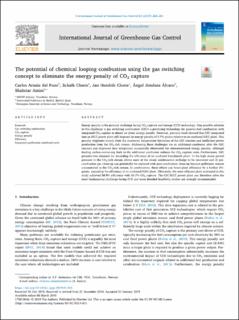| dc.contributor.author | Arnáiz del Pozo, Carlos | |
| dc.contributor.author | Cloete, Schalk Willem Petrus | |
| dc.contributor.author | Cloete, Jan Hendrik | |
| dc.contributor.author | Jiménez Álvaro, Ángel | |
| dc.contributor.author | Amini, Shahriar | |
| dc.date.accessioned | 2020-11-13T13:23:28Z | |
| dc.date.available | 2020-11-13T13:23:28Z | |
| dc.date.created | 2019-06-13T12:11:42Z | |
| dc.date.issued | 2019 | |
| dc.identifier.citation | International Journal of Greenhouse Gas Control. 2019, 83 265-281. | en_US |
| dc.identifier.issn | 1750-5836 | |
| dc.identifier.uri | https://hdl.handle.net/11250/2687844 | |
| dc.description.abstract | Energy penalty is the primary challenge facing CO2 capture and storage (CCS) technology. One possible solution to this challenge is gas switching combustion (GSC): a promising technology for gaseous fuel combustion with integrated CO2 capture at almost no direct energy penalty. However, previous work showed that GSC integrated into an IGCC power plant still imposed an energy penalty of 5.7%-points relative to an unabated IGCC plant. This penalty originates mainly from the maximum temperature limitation of the GSC reactors and inefficient power production from the CO2-rich stream. Addressing these challenges via an additional combustor after the GSC reactors and improved heat integration successfully eliminated the aforementioned energy penalty, although feeding carbon-containing fuels to the additional combustor reduces the CO2 capture ratio. Furthermore, GSC presents two channels for exceeding the efficiency of an unabated benchmark plant: 1) the high steam partial pressure in the CO2-rich stream allows most of the steam condensation enthalpy to be recovered and 2) pre-combustion gas clean-up can potentially be replaced with post-combustion clean-up because pollutants remain concentrated in the CO2-rich stream. In combination, these effects can boost plant efficiency by a further 2%-points, exceeding the efficiency of an unabated IGCC plant. Ultimately, the most efficient plant evaluated in this study achieved 50.9% efficiency with 80.7% CO2 capture. The GSC-IGCC power plant can therefore solve the most fundamental challenge facing CCS and more detailed feasibility studies are strongly recommended. | en_US |
| dc.language.iso | eng | en_US |
| dc.publisher | Elsevier | en_US |
| dc.rights | Attribution-NonCommercial-NoDerivatives 4.0 Internasjonal | * |
| dc.rights.uri | http://creativecommons.org/licenses/by-nc-nd/4.0/deed.no | * |
| dc.subject | Integrated gasification combined cycle | en_US |
| dc.subject | Efficiency | en_US |
| dc.subject | Energy penalty | en_US |
| dc.subject | CO2 capture | en_US |
| dc.subject | Gas switching combustion | en_US |
| dc.title | The potential of chemical looping combustion using the gas switching concept to eliminate the energy penalty of CO2 capture | en_US |
| dc.type | Journal article | en_US |
| dc.type | Peer reviewed | en_US |
| dc.description.version | publishedVersion | en_US |
| dc.rights.holder | Copyright: 2019 The Authors. Published by Elsevier Ltd. This is an open access article under the CC BY-NC-ND license (http://creativecommons.org/licenses/BY-NC-ND/4.0/). | en_US |
| dc.source.pagenumber | 265-281 | en_US |
| dc.source.volume | 83 | en_US |
| dc.source.journal | International Journal of Greenhouse Gas Control | en_US |
| dc.identifier.doi | 10.1016/j.ijggc.2019.01.018 | |
| dc.identifier.cristin | 1704619 | |
| dc.relation.project | EC/H2020/691712 | en_US |
| cristin.unitcode | 7401,80,40,0 | |
| cristin.unitname | Prosessteknologi | |
| cristin.ispublished | true | |
| cristin.fulltext | postprint | |
| cristin.qualitycode | 2 | |

